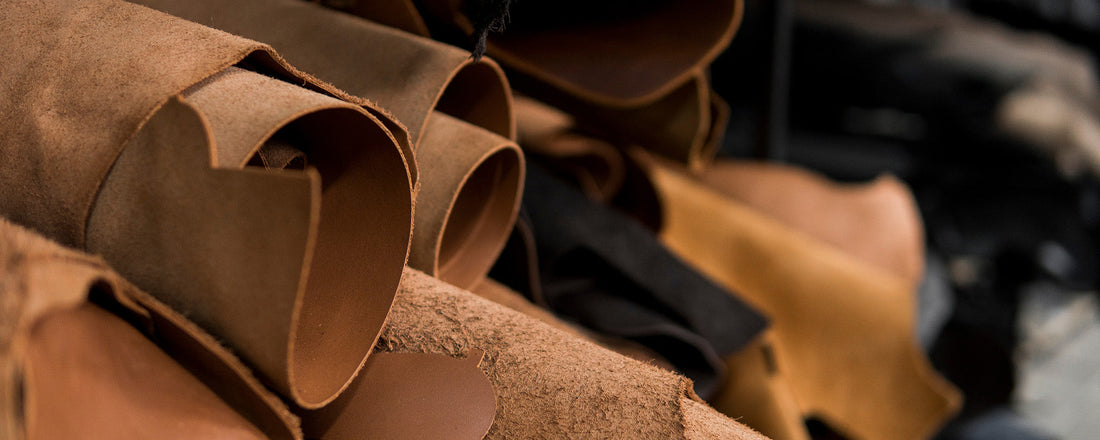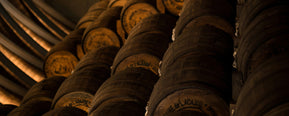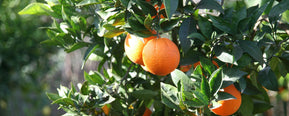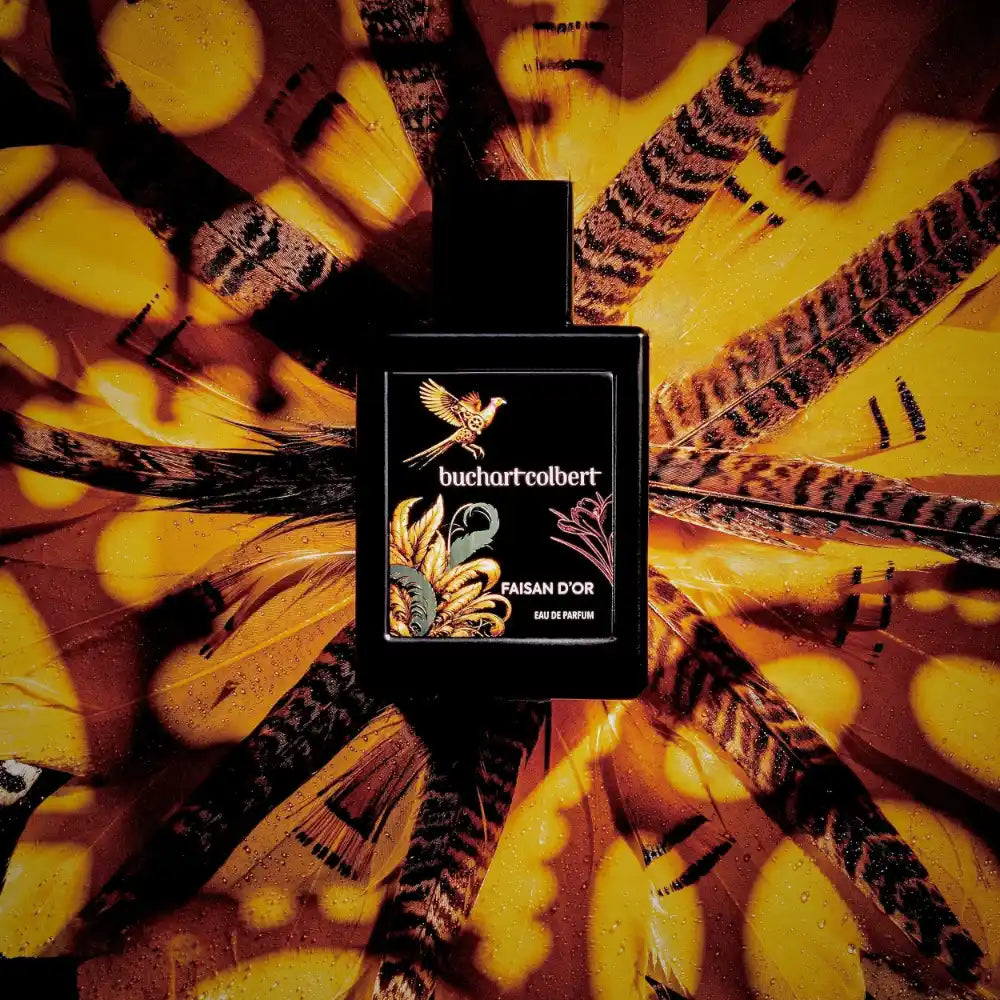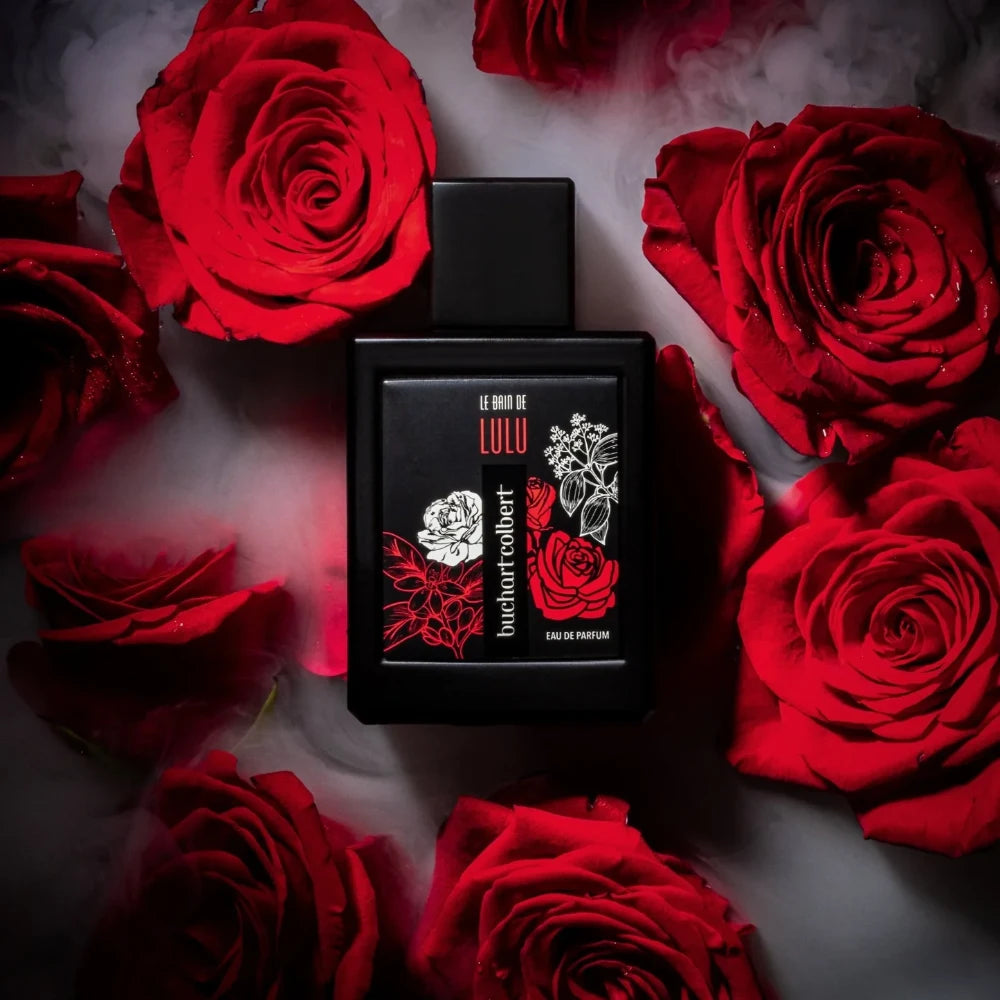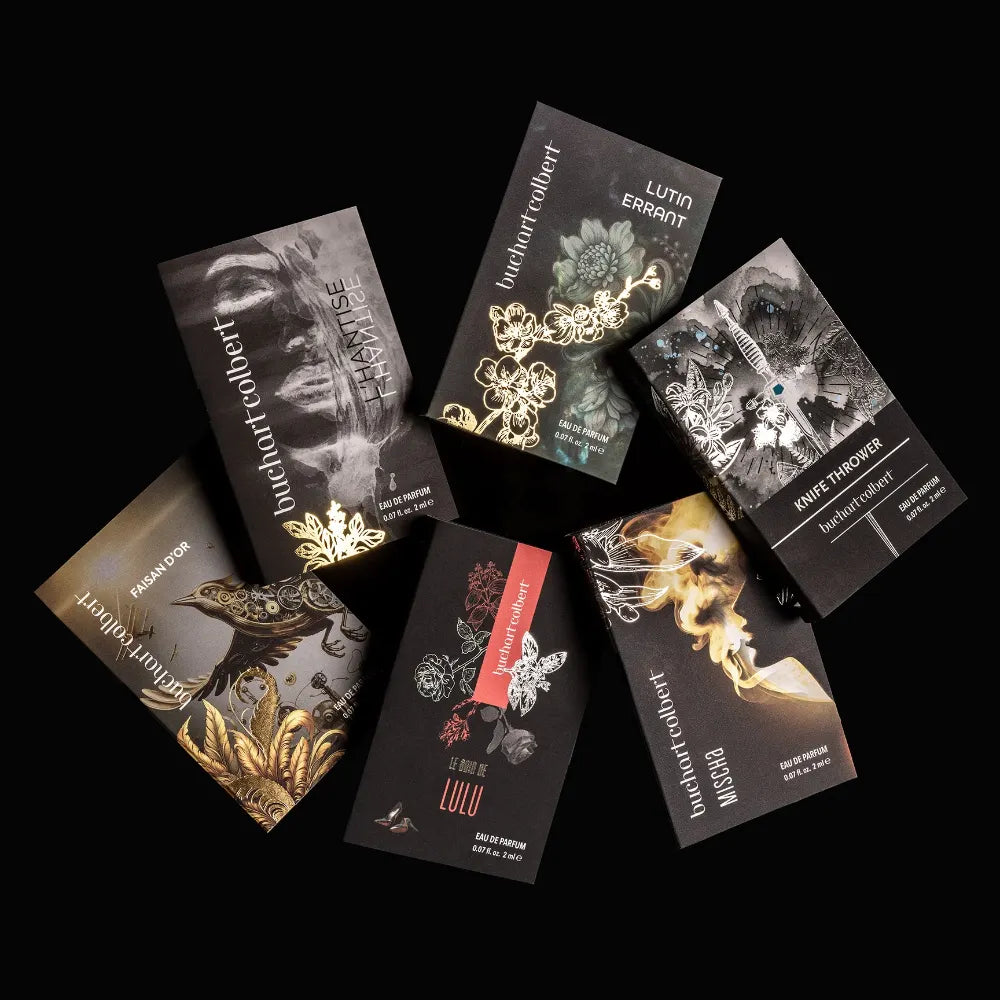Leather in perfume is not derived from the material itself; it is an accord, a carefully composed scent designed to replicate the olfactory essence of leather. This essence can range from soft suede to bold, smoky Russian leather, depending on the ingredients used.
In modern perfumery, leather accords are typically built using:
- Birch tar for smokiness
- Labdanum for resinous warmth
- Castoreum or styrax for animalic depth (now often synthetic)
- Isobutyl quinoline, a synthetic that adds a green-leather sharpness
These ingredients are blended to form what we recognize as a leather note.
This art of illusion allows perfumers to reinterpret leather in countless ways, from bold and smoky to refined and minimalist. And it's why leather remains one of the most versatile and evocative notes in niche perfumery.
What Does Leather Smell Like in Perfume?
In general, leather smells rich, warm, and slightly animalic, with a distinctive mix of smoky, woody, and earthy notes.
The scent can vary depending on the type of leather and how it's been treated or tanned, but here are the common characteristics people associate with the smell of leather:
- Smoky: Reminiscent of fireplaces, tanned hides, or charred wood
- Dry and woody: Often evoking old book covers or aged furniture
- Resinous: Thanks to materials like labdanum or styrax
- Animalic: With a musk-like earthiness that adds sensual depth
Some everyday analogies include:
- The inside of a new car
- A vintage leather-bound book that's sat on a shelf for decades
- A handcrafted leather bag, warm and softened with time
These elements combine to form a rich, enduring base note, anchoring the fragrance with gravitas.
Leather Fragrance Family
Leather, though unique, doesn’t stand alone. It finds its place within several fragrance families, often acting as a deep, grounding element that transforms a composition's identity. Depending on how it’s paired, the leather may lean woody, ambery, or chypre, offering a bridge between structure and sensuality.
Common Leather Fragrance Families:
- Woody-Leather: Earthy and bold, often paired with cedar, vetiver, or sandalwood. These evoke dry woods and refined interiors.
- Chypre-Leather: Blended with moss, bergamot, and patchouli to create a vintage, formal feel.
- Amber-Leather: Resinous and warm, often rich with labdanum and amber for a smoky, incense-like effect.
- Floral-Leather: Softened with jasmine, rose, or violet, these offer a more unisex or even traditionally feminine tone.
- Gourmand-Leather: Rare but rising in niche perfumery, leather meets plum, caramel, or vanilla for an indulgent twist.
Each of these families allows the leather to express different facets of its scents, sometimes mysterious and brooding, other times soft and almost buttery.
At Buchart Colbert, leather serves as more than a note; it’s an archetype, a narrative thread that anchors bolder compositions and draws out hidden harmonies in a perfume’s symphony.
Types of Leather Notes in Perfumery
Leather in perfumery is not monolithic. It appears in a variety of interpretations, each crafted to evoke a distinct mood or texture. These variations shape how a fragrance feels, whether it’s plush and powdery or smoky and austere. Let’s explore the most prominent types of leather notes found in fine fragrance.
Suede in Perfume: The Velvet Touch of Leather
Suede is the gentlest form of leather in perfume. It mimics the soft, velvety side of the material and is often achieved using notes like iris, white musk, or orris root. Suede-based compositions have a creamy, powdery texture, making them especially popular in modern unisex perfumes. Think of suede as leather with the volume turned down, intimate and tactile.
Russian Leather Scents: Smoky, Dry, and Masculine
A more traditional leather, Russian leather is bold and tarry. Derived from historical methods of tanning with birch oil, this note is smoky, dry, and masculine. It often appears in heritage-style fragrances and lends a sense of grit and grandeur, the kind of scent that conjures fur coats and stately parlors.
Birch Tar: The Backbone of Leather Scent in Perfume
Not technically a leather note but rather a key material in crafting one, birch tar gives leather its burnt, smoky character. When blended into a fragrance, it adds darkness, intensity, and sometimes a medicinal quality. Birch tar is often paired with resins and woods to build the classic leather accord.
White Leather: A Fresh Leather Scent
A newer interpretation in niche perfumery, white leather is clean, smooth, and less animalic. It often leans into modern aesthetics, minimal, bright, and transparent.
Think of it as the olfactory equivalent of finely stitched white suede gloves: elegant, quiet, and urbane.
These types of leather showcase how this one concept can stretch across genres, floral, woody, gourmand, or even green, offering endless creative potential for perfumers and fragrance lovers alike.
How Leather Scent Is Crafted in Perfume?
Leather, unlike rose or sandalwood, is not an extractable ingredient. It doesn’t bloom or distill. Instead, it is composed and built from scratch through a precise orchestration of raw materials. This is where perfumery becomes true alchemy.
History of Leather in Perfumery
The history of leather in perfumery begins in 16th-century Grasse, where glove makers faced a fragrant problem.
The leather tanning process produced strong, unpleasant odors, so artisans began scenting gloves with rosewater, orange blossom, and musk. These gants parfumés translated as scented gloves, became fashionable among European nobility and helped establish Grasse as a perfumery capital.
By the 18th century, leather evolved from masking scent to a stylistic signature. Russian leather, treated with birch oil, inspired some of the earliest leather accords in fine fragrance, capturing smoky, resinous qualities while adding florals and spices for elegance.
The early 20th century brought leather into mainstream perfumery with pioneering compositions that celebrated equestrian nobility and the romance of worn saddles. These groundbreaking fragrances sparked a wave of leather-based compositions that refined the note from raw and animalic to sophisticated and wearable.
Today, niche perfumers continue this legacy, creating everything from soft suede interpretations to white leather minimalism and gourmand-tinged compositions, proving leather's versatility beyond traditional masculine intensity.
Leather Scent Extraction Methods
Perfumers construct leather accords using entirely plant-based ingredients like natural resins, botanical extracts, and smoky elements (cade oil, birch tar, etc), creating the rich essence of leather through completely vegan formulations.
Historically, leather aromas emerged from the tanning process, particularly from birch tar.
Over time, perfumers transformed this raw intensity into more polished, evocative interpretations and elevated leather from functional to fragrant.
Natural Leather Materials
- Birch Tar: Adds a powerful, smoky aroma central to traditional leather notes.
- Labdanum (Cistus ladaniferus): A sticky resin that lends a warm, ambery base to mimic the richness of aged leather.
- Styrax: Balsamic and slightly spicy scent, used to round out leather accords.
- Castoreum: Once derived from beaver glands, now largely synthesized; adds a musky-animalic intensity to deepen leather’s realism.
Synthetic Leather Notes
- Isobutyl Quinoline: A classic synthetic used since the early 20th century. Sharp and green, it evokes the scent of new leather goods.
- Suede and other modern aroma chemicals: These allow perfumers to create suede, white leather, or ultra-clean leather variants.
Thanks to these ingredients, perfumers can dial leather up or down from the assertive scent of vintage trunks to the delicate whisper of suede gloves or even expand the scent longevity up to 10 hours. It’s a flexible note that adapts to genre, gender, and seasonality.
Best Notes to Pair with Leather
Leather is a bold and textured base note, but its full potential is unlocked through thoughtful pairing. Like a musical chord, it thrives in harmony with contrasting and complementary notes. Whether deepened, sweetened, or brightened, leather becomes more expressive when supported by the right olfactive companions.
Leather combined with Floral and Powdery Notes
- Iris (Iris pallida): Adds a powdery, aristocratic softness. It refines leather, transforming it into suede-like elegance.
- Violet: Enhances the plushness of suede or white leather. Often used in unisex or feminine-leaning blends.
- Rose: Juxtaposes leather’s darkness with romantic brightness, perfect for chypre-leather hybrids.
Fruity and Gourmand Notes to balance the smoky leather scent
- Plum: Rich and velvety, it creates a decadent balance when layered with smoky leather.
- Caramel or vanilla: Adds gourmand indulgence, softening the harsh edges of leather.
- Fig or dried fruits: Lend complexity and warmth, drawing out the leathery sweetness.
Woody and Resinous Notes to add warmth to the leather perfume
- Cedarwood and sandalwood: Reinforce the dry, structured qualities of leather.
- Vetiver: Grounds leather in green smokiness, enhancing its earthy side.
- Amber: A great ingredient to expand longevity, also adding a warm sweetness to leather scent.
More Exotic Vibe with Spices and Smoke
- Saffron: Introduces a luminous, leathery spiciness that feels exotic and smooth.
- Tobacco: Intensifies the smoky depth, often used in masculine or warm, earthy compositions.
- Incense and myrrh: Bring a sacred, resinous finish, elevating leather into the realm of ritual and memory.
These combinations are why the best leather niche perfume compositions vary widely; some are bracing and bold, others soft-spoken and sensual. Leather is not a singular destination, but a journey shaped by its pairings.
Plant-Based Leather Alternatives
As consumer preferences shift toward ethical and sustainable formulations, perfumers are innovating with plant-based leather alternatives. These compositions mimic the scent of leather using only botanical ingredients, no animal-derived or petroleum-based synthetics, without sacrificing complexity.
Botanical Building Blocks
- Violet Leaf Absolute: Offers a green, slightly metallic edge that resembles the top note of new leather.
- Cistus (Rock Rose): Rich in labdanum, this resin provides warmth and tenacity, key to leather’s base.
- Clary Sage: Herbal and slightly leathery on its own, it adds texture and depth to suede-inspired blends.
- Oakmoss: Earthy and damp, it’s often used to simulate the vintage, worn facets of leather.
In Le Bain De Lulu, we layer this botanical impression with soft florals, caramel, and plum, crafting a scent that feels like the velvet lining inside a vintage vanity case - lush, nostalgic, and quietly sensual.
Here, oakmoss plays a crucial role, grounding the composition with a mossy and suede-like warmth that lingers like a whispered memory.
The Misconception of Leather in Perfume
Leather, as a scent, carries with it a series of assumptions, many of which are outdated. To understand its true elegance, one must move beyond the stereotypes and uncover the artistry behind its creation.
Misconception 1: Leather in Perfume Smells Like a New Car Interior
While some mass-market fragrances chase the synthetic sharpness of automobile leather, fine perfumery rarely mirrors this. Instead, leather accords in niche fragrances evoke refined textures: antique trunks, worn gloves, polished saddlery, or soft suede jackets. The goal isn’t realism, it’s emotion and memory.
Misconception 2: Leather Is Only for Men
Leather’s bold character has long been associated with masculinity, but that view is shifting. Many contemporary compositions balance leather with florals, fruits, or gourmand notes, making it just as appealing for feminine or unisex scents. Suede and white leather interpretations are among the most versatile and widely worn across genders.
Misconception 3: Leather Is Derived from Animal Hides
In perfumery, leather is an illusion, crafted through a blend of resins, woods, and synthetics. Even traditional ingredients like castoreum or civet are now replicated with cruelty-free alternatives. Moreover, plant-based leather accords are gaining popularity, offering ethical and aromatic richness.
Misconception 4: Leather Always Smells Harsh or Dirty
While some leather perfumes are intentionally animalic or smoky, many are soft, powdery, even floral. Suede interpretations, in particular, are beloved for their understated charm. Leather is a chameleon; it adapts to the vision of the perfumer and the desires of the wearer.
By breaking these misconceptions, one begins to see leather not as a category to avoid, but as a palette of expression, bold, subtle, nostalgic, and endlessly reimagined.
Leather in Buchart Colbert Fragrances
At Buchart Colbert, scent is a language, a means of storytelling shaped by music and memory. Leather, in this context, is more than a note. It is a symbol of tension and tenderness, boldness and restraint.
While Buchart Colbert does not focus exclusively on leather-centric perfumes, the influence of leather’s olfactive character can be found woven subtly into several compositions. Most notably:
- Faisan d'Or: This opulent blend features suede in the heart, gently spiced with cinnamon and pink pepper. The suede here is creamy and warm, nestled between gourmand top notes of caramelized sugar and a smoky, amber-wood base. It evokes the plush lining of a vintage coat, familiar, indulgent, and intimate.
- Lutin Errant with rum, coconut, and mushroom at its heart, this scent reads whimsical and grounded. The drydown, rich with cedar and amber, has a forest-floor richness that echoes the atmospheric density of a soft, worn leather pouch, quietly wild and textural.
FAQs
1. What is leather perfume?
Leather perfume refers to a fragrance that features a leather accord, an olfactive composition meant to replicate the scent of leather using resins, woods, and synthetics. It can be smoky, dry, or soft, like suede.
2. What does leather smell like in fragrance vs real leather?
In fragrance, leather is an artistic interpretation. While real leather may smell sharp or industrial due to tanning, perfume leather is crafted to evoke refined textures, often warmer, smoother, and more wearable than the real thing.
3. Is leather used directly in perfume?
No. Leather itself is not an extractable note. Instead, perfumers use materials like birch tar, labdanum, and isobutyl quinoline to recreate leather’s aroma.
4. Are leather perfumes unisex?
Absolutely. While traditionally associated with masculinity, modern leather scents span all gender expressions. Suede, floral-leather, and gourmand-leather compositions are especially popular among unisex offerings.
5. What is the best leather perfume note to wear in summer?
Lighter versions, such as white leather or suede, especially when paired with citrus or florals, work beautifully in warmer weather. Look for airy compositions that balance depth with brightness.
